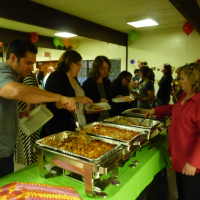Feasts can be large or small, their purpose can be to honor and praise anything, from a formal reception, to a fine Christmas dinner, to a casual summer backyard barbecue. The purpose is left only to the imagination and the desire to celebrate and have fun. But, of course, much of the event's success will be in the details. It's imperative to plan ahead.
Feasts can be amazingly expensive or surprisingly economical. How many people will be invited? How will the guests receive their invitations? Where will the feast take place? Who will provide the food and drink? How will the tables be set? Who or what will provide the entertainment? Will there be live music, a DJ, or pre-planned song lists? Will there be games? Table gifts? Professional acts? Comedy? Gambling tables? Certainly, the theme of the event with its thematic décor will impact the budget, too. Will it be a Halloween bash? A masquerade? A Medieval boar's head feast? Will the room reflect a pirate's bounty? Outer space? Whatever the theme, even decorations can be inexpensive if planned just right.
What About the Guests?
It proves difficult sometimes to include everyone you know on the guest list. That is to say, the guest list should match the function. Sometimes, too, the host only knows the indended guest, and not the guest's "significant other." In many cases, it is appropriate to include a "plus one" invite in the invitation. Study your planned guest list well, too. You don't want to commit a major faux pas by leaving someone off the list.
What About the Food?
Often, the menu choices will be dictated by the theme of the feast. Taco Party? Forth of July? Thanksgiving? Birthday? Whatever the theme, from appetizers through the entire meal -- including breads, desserts and beverages -- it's sometimes important to offer a variety of choices, including dishes and drinks especially prepared for any dietary concerns. Will there be fresh baked wheat bread? Be sure to include a non-gluten alternative. Potatoes au gratin? Offer a non-dairy potato dish as for the lactose-intolerant. Of course, there are other times when what's served is what's served, and if the guest finds something that doesn't match their tastes or desires, they will simply have to pass that item by.
If the event is to be catered, or serviced by a single in-home chef, it's important to make sure that the menu reflect not only the theme, but also the general and specific tastes and requirements of the invited guests. If the feast is a pot-luck, it can be efficient to ask guests with specific dietary tastes and requirements to bring dishes and/or beverages that provide for their specific needs.
What About the Dress?
Dress code matters, especially if the event is themed. For example, say there's an end of summer party called "The Black & White Party," and the invitations explicitly state that wearing black and/or white is mandatory, although since it is a whimsical backyard party, guests are invited to wear any combination of black and white they wish. Nevertheless, if a guest arrives not wearing any combination of black and white, in gest, the host rings a loud gong to alert the party guests of the arrival's "hedious violation of etiquette."
Certainly, the more the guests adhere to a proposed dress code, the more flavorful and successful the event appears, especially in post-party photographs.
At certain themed parties, such as Halloween, there can be actual contests for the "best costume" or the "best dressed." Details about such "party games" can be included in the invitation.
What About the Decorations and the Table Settings?
If the room is especially drab or boring, wall decorations and lighting can especially transform the event. Sometimes, though, a themed event calls for wall decorations and special lighting even if the room is interesting. The dining and serving tables are also perfect places to set the mood.
It's also fun to create points of interest around the room to gather people together around meaningful objects, photos, memorabilia, etc. At some parties, like birthday parties and weddding anniversaries, it's fun to hang a photo history line along a wall or hallway that will invite guests to view the images as if in a gallery. Historic photographs can include people attending the party which will give everyone a way to connect the present with the past. Another idea is to set a table that exhibits meaningful objects that fit the theme of the party.
Diary and post card books can be placed on a table so that guests can write greetings and memories, etc.
Sometimes, such as at wedding receptions and work related events, a seating chart might be in order. Also, too, sometimes certain seats at the table might need to be reserved, such as when table location is important and there's a guest of honor.
You'll Want Photographs!
As everyone knows, photos keep the memories alive. Professional photographers can be expensive, and with certain events, their services are often needed. These days, too, just about everyone has a smart phone with an excellent low-light camera. It can be great to encourage your guests to take photos and group selfies, then invite them to share their snapshots on social media.
All in all, creating a feast for friends and collegues is to celebrate life. Good luck! And, have a grand time.


